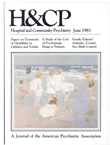Reducing Childhood Disability in the 80s
Abstract
Childhood disability is now known to be a major public health problem throughout the world. It is estimated that in 1975 about 10 percent of the world's 1.4 billion children sufI ered from one or more disabilities. The authors discuss the patterns and causes ofchildbood disability from an international perspective and outline a number of factors that will continue to influence the incidence of disability in the 1 980s. They conclude by suggesting several strategies f or change, both national and international in nature, to help prevent disability and to care for disabled children.
Access content
To read the fulltext, please use one of the options below to sign in or purchase access.- Personal login
- Institutional Login
- Sign in via OpenAthens
- Register for access
-
Please login/register if you wish to pair your device and check access availability.
Not a subscriber?
PsychiatryOnline subscription options offer access to the DSM-5 library, books, journals, CME, and patient resources. This all-in-one virtual library provides psychiatrists and mental health professionals with key resources for diagnosis, treatment, research, and professional development.
Need more help? PsychiatryOnline Customer Service may be reached by emailing [email protected] or by calling 800-368-5777 (in the U.S.) or 703-907-7322 (outside the U.S.).



